Chapter 1: basic concepts of server
1.1 - composition of the website
Web applications are mainly divided into two parts: client and server.
- Client: the part that runs in the browser is the interface program that the user sees and interacts with. Build using HTML, CSS, JavaScript.
- Server side: the part running in the server, responsible for storing data and processing application logic.
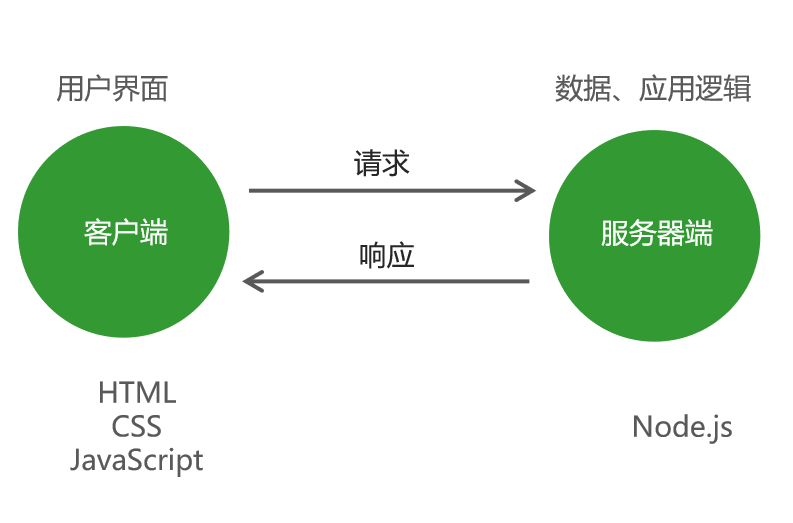
1.2-Node website server
The machine that can provide website access service is website server, which can receive client's request and respond to the request.

1.3-IP address
Unique identification of the device in the Internet.
IP is the abbreviation of Internet Protocol Address, which represents the Internet Protocol Address.
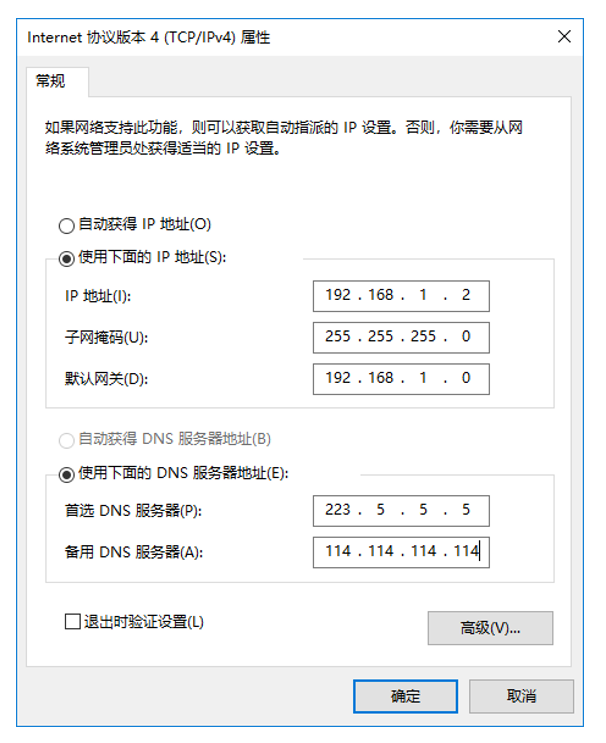
1.4- domain name
Because the IP address is hard to remember, the concept of domain name comes into being. The so-called domain name is the web address used for surfing the Internet at ordinary times.
http://www.baidu.com => http://39.156.66.14/
Although the address is entered in the address field, the domain name will eventually be converted to ip to access the specified website server.
1.5- port
The port is the outlet of communication between the computer and the outside world, which is used to distinguish the different services provided by the server computer.
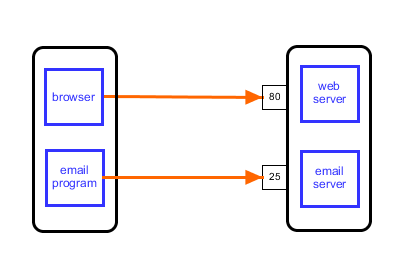
1.6-URL
The Uniform Resource Locator, also known as the Uniform Resource Locator, is a kind of addressing method specially designed to identify the location of resources on the Internet. The webpage address we usually refer to is the URL.
URL composition: Transport Protocol: / / server IP or domain name: port / resource location ID
https://www.baidu.com/index.html
1.7 - client and server during development
In the development phase, the client and server use the same computer, that is, the developer computer.
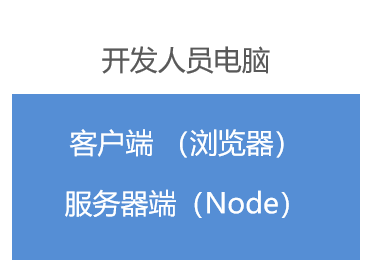
Local domain name: localhost
Local IP: 127.0.0.1
Chapter 2: creating a web server
// 1. Import http module const http = require("http"); // 2. Create a web server object const app = http.createServer(); // 3. Register the request event with the server, listen to and respond to user requests app.on("request", (req, res) => { // Response client res.end("Hello!") }); // 4. Listening port 4000 app.listen(4000);
In local browser: input address → localhost:4000
Chapter 3: HTTP protocol
3.1- concept
HyperText Transfer Protocol (HTTP) specifies how to transfer HyperText from website server to local browser. It works based on client server architecture and is the standard for client (user) and server (website) requests and responses.
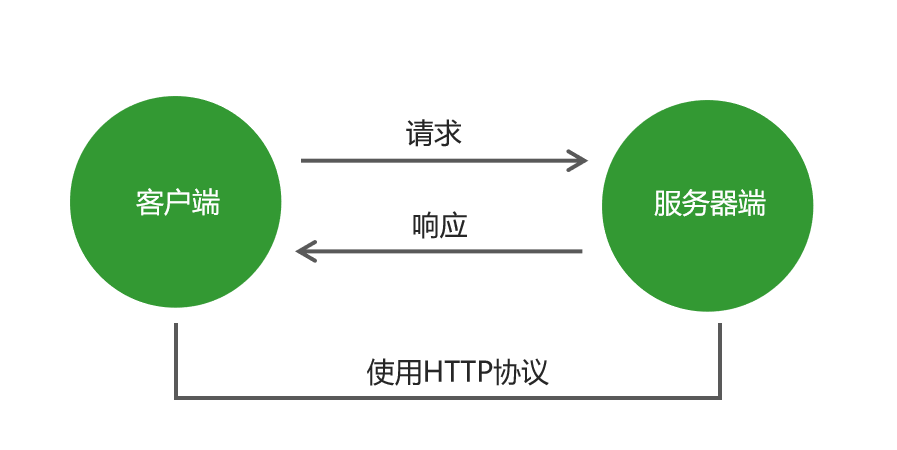
3.2- message
The data block passed in the process of HTTP request and response is called message, including the data to be transmitted and some additional information, and it should follow the prescribed format.
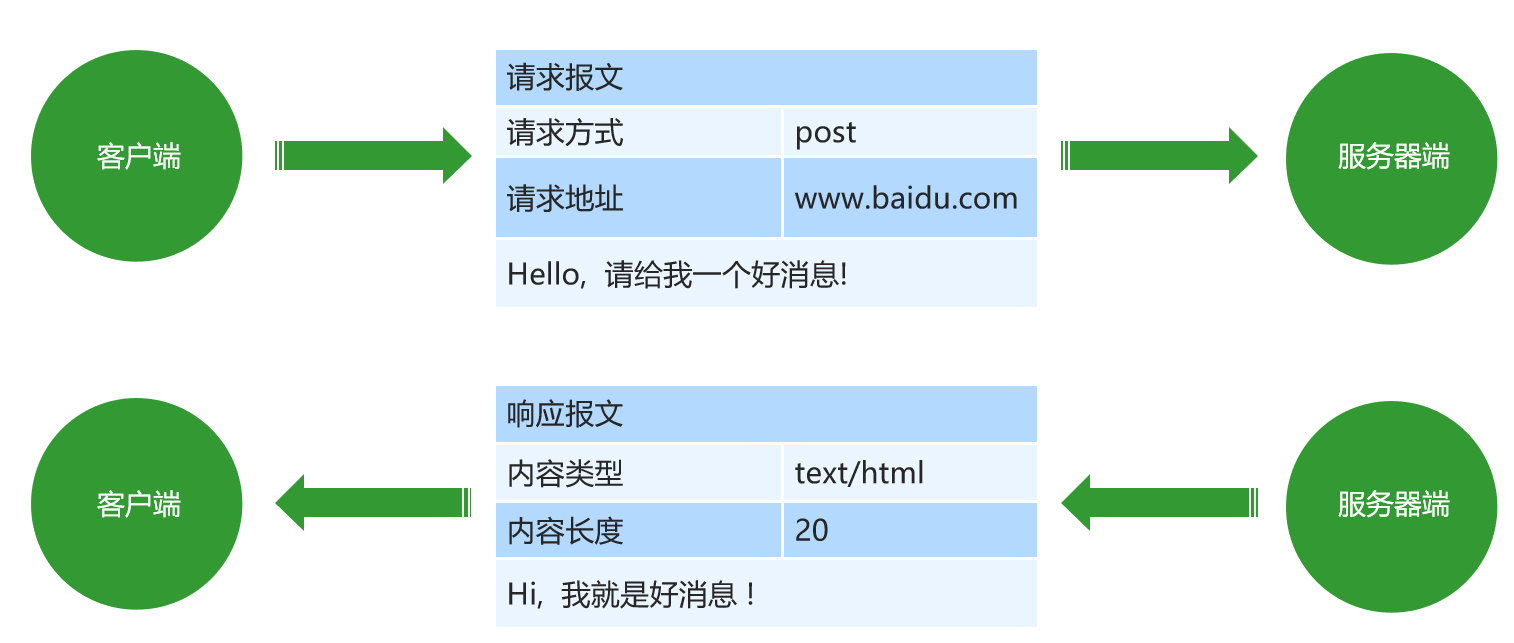
3.3 - request message
Request mode
- get
- post
Request address
const http = require("http"); const app = http.createServer(); app.on("request", (req, res) => { // Get request message console.log(req.headers); // Get the path of the request console.log(req.url); // How to get the request console.log(req.method); }); app.listen(4000);
3.4 - response message
HTTP status code
200 request succeeded
404 requested resource not found
500 server side error
400 syntax error in client request
Content type
text/html
text/css
application/javascript
image/jpeg
application/json
Code demo
const http = require("http"); const app = http.createServer(); app.on("request", (req, res) => { // Set response message (status code and content type and code of response) res.writeHead(200, { "Content-Type":"text/html;charset=utf-8" }) res.end("<h1>Hello!</h1>"); }); app.listen(4000);
Chapter 4: HTTP request and response processing
4.1 - request parameters
When the client sends a request to the server, sometimes it needs to carry some customer information, which needs to be passed to the server in the form of request parameters, such as query operation, login operation, etc.

4.2-GET request parameters
Parameters are placed in the browser address bar, for example: http://localhost:3000/?id=1&type=2
Parameter acquisition needs the help of system module url, which is used to process url address
const http = require("http"); // [import url module] const url = require("url"); const app = http.createServer(); app.on("request", (req, res) => { // [convert req.url to object, and deconstruct [request path] and [request parameters in object format]] let {query,pathname} = url.parse(req.url, true); // Request path console.log(pathname); // Request parameter object console.log(query); }); app.listen(3000);
4.3-POST request parameters
Parameters are placed in the request body for transmission
data event and end event are required to get POST parameters
Using querystring system module to convert parameters to object format
Form:
<form action="http://localhost:4000" method="POST">
User name: < input type = "text" name = "username" >
Password: < input type = "password" name = "PWD" >
<input type="submit">
</form>
node services
const http = require("http"); // Import querystring module const querystring = require("querystring"); const app = http.createServer(); app.on("request", (req, res) => { // Define variables, receive client post request parameters let paramsStr = ""; // Register data event receive parameter data req.on("data", (chunk) => { paramsStr += chunk }); // Register end event and handle after receiving req.on("end", () => { let paramsObj = querystring.parse(paramsStr); console.log(paramsObj); }); }); app.listen(4000);
4.4- routing
Routing refers to the correspondence between the client request address and the server program code. In short, it's the response to the request.
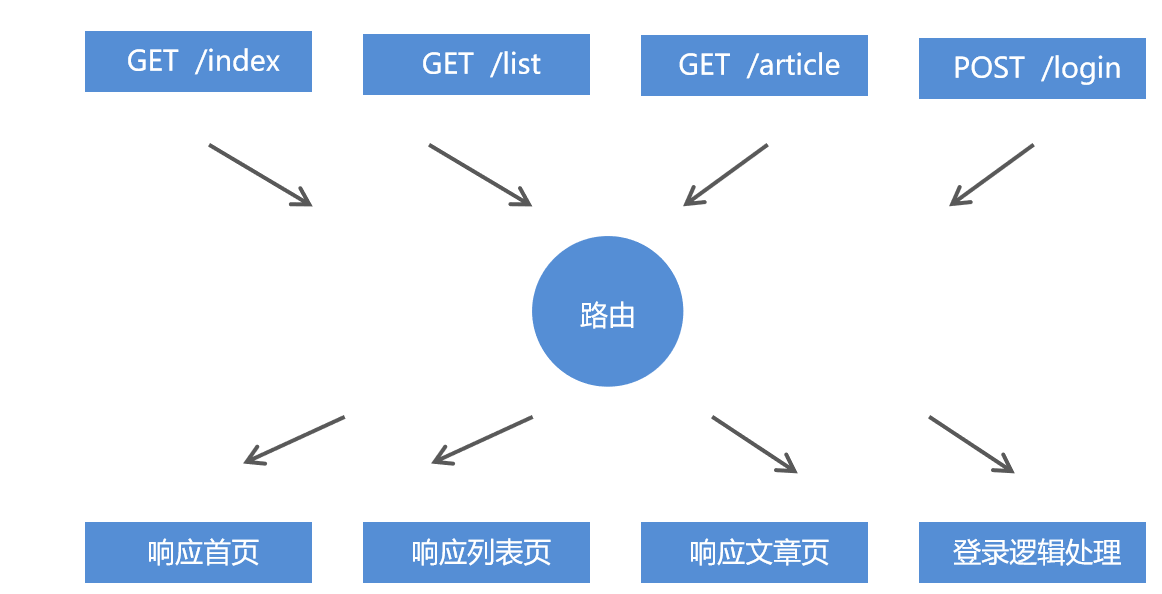
const http = require("http"); const url = require("url"); const app = http.createServer(); app.on("request", (req, res) => { // Get the path of the request let { pathname } = url.parse(req.url, true); // Set response header res.writeHead(200, { "content-Type": "text/html;charset=utf-8" }); // Processing routing if (pathname == "/index.html" || pathname == "/") { res.end("<h1>home page</h1>"); } else if (pathname == "/list.html") { res.end("<h1>List page</h1>"); } else { res.writeHead(404, { "content-Type": "text/html;charset=utf-8" }); res.end("<h1>Page does not exist</h1>"); } }); app.listen(4000);
4.5 - static resources
The server does not need to process. The resources that can directly respond to the client are static resources, such as CSS, JavaScript, image files.
https://m.360buyimg.com/babel/jfs/t1/36002/35/9106/3311/5cd4f1bdE06ff07ed/9570fdd46ecd3a76.png

const http = require("http"); const url = require("url"); const path = require("path"); const fs = require("fs"); // Import third-party module mime const mime = require("mime"); const app = http.createServer(); app.on("request", (req, res) => { // Get the path of the request let { pathname } = url.parse(req.url, true); // Physical path of files on splicing server let realPath = path.join(__dirname, "public", pathname); // Get the requested resource type let type = mime.getType(realPath); console.log(realPath); // Read server local file fs.readFile(realPath, (err, data) => { if (err) { res.writeHead(404,{"Content-type":type+";charset=utf-8"}); res.end("Access resource does not exist"); return; } res.writeHead(200); res.end(data); }); }); app.listen(4000);
4.6 - Dynamic Resources
Different response resources with the same request address are dynamic resources.
https://www.baidu.com/s?wd = beauty

https://www.baidu.com/s?wd = handsome guy

4.7 - client request path
- GET mode
- Browser address bar
- The link tag's href attribute
- src attribute of script tag
- src attribute of img tag
- Form form submission
- POST mode
- Form form submission
Chapter 5: Node asynchronous programming
5.1 - synchronous API, asynchronous API
Synchronization API: the next API can only be executed after the current API is executed
console.log('before'); console.log('after');
Asynchronous API: the execution of the current API will not block the execution of subsequent code
console.log('before'); setTimeout( () => { console.log('last'); }, 2000); console.log('after');
Difference 1: difference between synchronous API and asynchronous API (return value):
// [synchronization] function sum (n1, n2) { return n1 + n2; } const result = sum (10, 20); // Results: 30 // [asynchronous] function getMsg () { setTimeout(function () { return { msg: 'Hello Node.js' } }, 2000); } const msg = getMsg (); // Result: undefind
Difference 2: difference between synchronous API and asynchronous API (code execution order)
- The synchronization API executes from top to bottom, and the previous code will block the subsequent code
- The asynchronous API does not wait for the API to complete before executing the code downward
5.2 - callback function
Basic definition and use of callback function
// getData function definition function getData (callback) {} // getData function call getData (() => {});
Using callback function to get asynchronous API execution result
function getMsg (callback) { setTimeout(function () { callback ({ msg: 'Hello Node.js' }) }, 2000); } getMsg (function (msg) { console.log(msg); // Result: Hello Node.js });
5.3 - asynchronous code execution sequence analysis
console.log('Code execution begins'); setTimeout(() => { console.log('2 Code executed in seconds'); }, 2000); setTimeout(() => { console.log('"0 second"Code executed after'); }, 0); console.log('Code end execution');
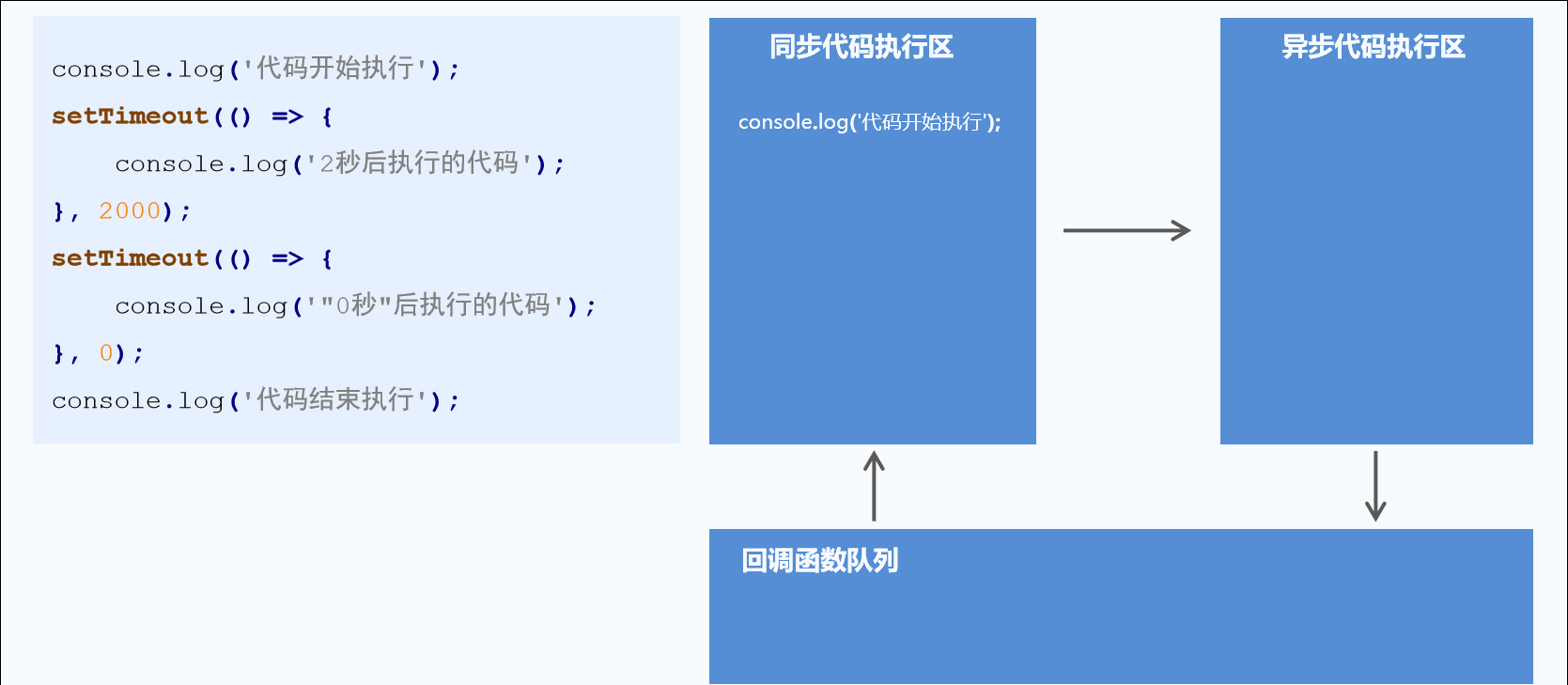
Asynchronous API in 5.4-Node.js
Requirements: read A file, B file and C file in turn
const fs = require("fs"); // Read file 1 fs.readFile("./public/a.txt", "utf-8", function (err, data) { console.log(data); fs.readFile("./public/b.txt", "utf-8", function (err, data) { console.log(data); fs.readFile("./public/c.txt", "utf-8", function (err, data) { console.log(data); }) }) });
Problem: too many nested callbacks, and the code is not easy to maintain
Solution: Promise object
5.5-Promise object
Basic use
let p1 = new Promise((resolve, reject) => { // resolve indicates the function after successful execution // reject represents the function in case of exception fs.readFile("./public/1.txt", "utf-8", function (err, data) { if (err) { reject(err); } else { resolve(data); } }); }); p1 // Operation after successful execution .then((data) => { console.log(data) }) // Action on exception .catch((err) => { console.log(err) });
Fulfill demand
const fs = require("fs"); function p1() { return new Promise((resolve, reject) => { fs.readFile("./public/a.txt", "utf-8", (err, data) => { if (err) { reject(err); } else { resolve(data); } }); }); } function p2() { return new Promise((resolve, reject) => { fs.readFile("./public/b.txt", "utf-8", (err, data) => { if (err) { reject(err); } else { resolve(data); } }); }); } function p3() { return new Promise((resolve, reject) => { fs.readFile("./public/c.txt", "utf-8", (err, data) => { if (err) { reject(err); } else { resolve(data); } }); }); } p1() .then((data) => { console.log(data); return p2(); }) .then((data) => { console.log(data); return p3(); }) .then((data) => { console.log(data); })
5.6 - asynchronous functions
Asynchronous function is the ultimate solution of asynchronous programming syntax. It allows us to write asynchronous code in synchronous form, so that the code no longer has callback function nesting, and the code becomes clear.
Keyword: async
Syntax: async function fn() {} or const FN = async() = > {};
- Add async keyword before the definition of ordinary function ordinary function becomes asynchronous function
- Asynchronous function returns promise object by default
- Use the return keyword inside the asynchronous function to return results. The result will be returned by the return keyword in the wrapped promise object instead of the resolve method
- Using throw keyword to throw program exception inside asynchronous function
- Call asynchronous function and then chain call then method to get the execution result of asynchronous function
- Call asynchronous function and chain call catch method to get the error information of asynchronous function execution
let fn1 = async () => { // throw "abnormal"; return "success"; }; fn1() .then((data) => { console.log(data) }) .catch((err)=>{console.log(err)})
Keyword: await
- The await keyword can only appear in asynchronous functions
- await promise await can only be followed by promise object. It is not allowed to write API of other types
- The await keyword pauses asynchronous function execution until promise returns the result
Fulfill demand
const fs = require("fs"); // It is used to modify the existing asynchronous function api to return promise object, so as to support the syntax of asynchronous function const promisify = require("util").promisify; let readFile = promisify(fs.readFile); async function run() { let f1 = await readFile("./public/1.txt", "utf-8"); let f2 = await readFile("./public/2.txt", "utf-8"); let f3 = await readFile("./public/3.txt", "utf-8"); console.log(f1); console.log(f2); console.log(f3); } run();